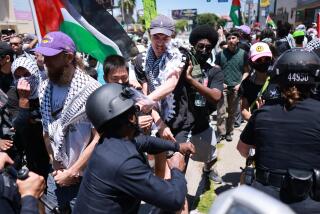Traffic Wizard Helped Downtown Go With the Flow
In his undistinguished white city van, Aram Sahakian has been leading protest marches all week. But the protesters don’t know it.
Sahakian, during convention week, has been Los Angeles’ super traffic cop.
In a city full of VIPs, no one may have been more important than Sahakian, a sort of Pied Piper of the streets as he led one choreographed march after another through the city.
Sahakian, an employee of the Los Angeles Department of Transportation, ordered signal lights turned red or green ahead of the marches, supervised the crews that erected barricades and stretched yellow tape across intersections, and fretted about keeping traffic moving.
You may have missed him. He was the stocky 36-year-old guy with a four-day growth of beard, wearing the lime-green fluorescent vest with orange stripes. Normally, Sahakian is a transportation engineer with the low-profile job of handling detours and route changes on Metro Rail construction projects.
This week he was the one out in front.
As the unofficial grand marshal during one parade, Sahakian found himself trailed by columns of police on foot and on motorcycles, chanting, banner-carrying demonstrators, then more and more police, three columns of patrol cars, and finally, firetrucks and ambulances bringing up the rear.
If you were blocked at a downtown intersection for 10 or 15 minutes, or if your delegate bus was an hour late, or if you had to sit in a taxicab without air-conditioning while the driver tried to navigate a detour, there was plenty of blame to go around.
You could blame Mayor Richard Riordan, who was instrumental in bringing the convention to downtown Los Angeles. Or you could curse the political idealism of the demonstrators, who jammed city streets with as many as 11 marches a day.
Or you can blame Sahakian, the man who gave the orders to actually close the streets.
Though Sahakian often seemed like a one-man gang, hanging “No right turn” signs or laying out orange cones himself, he was fed constant updates from a large supporting cast via a walkie-talkie.
On the street, Sahakian works with seven unarmed traffic control officers on bicycles, two crews in trucks to drop off and pick up cones, and a second van.
Dozens more LADOT supervisors and technicians staff a state-of-the-art computer center in City Hall East and a command post in Exposition Park. They have been overseeing not only marches but also street closures, the movement of 265 delegate buses that have been shuttling convention attendees from hotels to Staples Center, and sorting out other logistics problems.
Sahakian could order lights changed and get instant gratification because the city pioneered the computerized synchronization of traffic signals. About 2,700 traffic lights are linked to 10 mainframe computers, allowing someone at a computer to change a light from red to green, or a series of them, by tapping a computer keyboard.
Helping feed information into the system are tens of thousands of electronic sensors embedded in city streets and 150 closed-circuit television cameras mounted on poles and buildings at strategic locations around the city. There was also a helicopter hovering overhead.
So, while Sahakian was at ground zero, he could give orders from the street and see them carried out almost instantly.
“Flush out Main Street,” he said at one point during the anti-police march that would eventually snake past Macy’s Plaza. That’s traffic engineer’s jargon to turn lights green and keep them that way until traffic jams clear up.
Within seconds, buses, cars and delivery trucks that had been stopped for 10 minutes on Main at 1st Street began moving.
During marches, Sahakian kept one eye on the street ahead to make sure it stayed open and the other on his rearview mirror to make sure the parade was following him along the specified route.
At one point, during the anti-police march, officers formed a wall blocking Temple Street, rather than Broadway, which would have kept the marchers moving toward the 101 Freeway, rather than turning southeast.
“Uh-oh, the march is supposed to make a right turn at this location,” Sahakian said. “I have to find out what the deal is.” After a quick huddle with police, the wall of blue uniformed cops jumped over to Broadway, opening up Temple.
Later, after straightening out a bomb-scare-related traffic jam at the Civic Center, and getting the parade back on track after an unscheduled surge up 1st and Spring streets, Sahakian had everyone on track, heading toward Staples Center with the parade behind him.
When the march ended in front of Staples Center, 2 1/2 hours after it began, Sahakian was elated.
“We brought ‘em in,” he told his crew via the walkie-talkie. “We’re looking good.”
More to Read
Sign up for Essential California
The most important California stories and recommendations in your inbox every morning.
You may occasionally receive promotional content from the Los Angeles Times.










